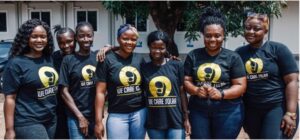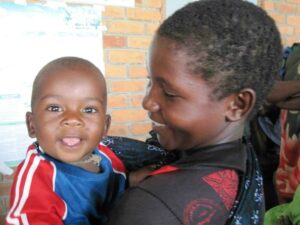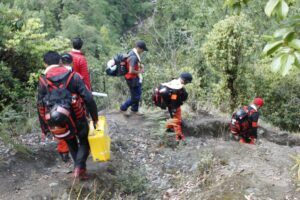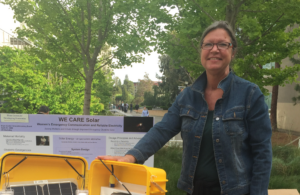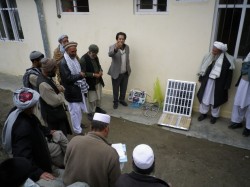I haven’t had a regular source of access to the internet so I apologize for the lack of updates.
I arrived in Nigeria after a brief stop in Italy, where Renaissance artwork depicting night life by candlelight and women who died in childbirth reminded me that until the last century the issues WE CARE Solar addresses were central throughout the world.
This trip to Nigeria is primarily to work with Population Reproductive Health Partnership on a hospital ethnographic research project. My own dissertation research focused on the delivery of obstetric care in one state hospital. The current project involves the participation of several Nigerian obstetrician-gynecologists in this kind of work. We are extending the ethnography to two other hospitals. One is the federal teaching hospital, a tertiary care center which is the virtual ‘gold standard’ for health care in this region. The other is a state hospital close to one of the villages in which we are conducting our community based projects, including life skills groups for girls, and prenatal care groups modeled after a group-care model called CenteringPregnancy.
I came earlier this year to train the obstetricians in the techniques of ethnography. I am guessing that we are the only group of highly skilled obstetricians in the world working on a collaborative hospital ethnography project in a developing country. It’s a particular treat for me to have the honor of working with these physicians – their understanding of the language, cultural, society and clinical norms in Nigeria deepen my ability to understand the scenes that became familiar to me over the last two and a half years.
We reviewed their recent field work in the tertiary care hospital, and tried to understand the dynamic interplay of human resources, clinical area and hospital infrastructure. Even though all of these doctors were trained in the tertiary hospital, they learned a great deal about the functioning of labor and delivery by conducting their research. It’s one thing to be a physician and briefly sweep through labor and delivery to check on a particular patient. It’s another to spend hour after hour watching the interaction of patients, nurses, attendants and doctors. The care and resources at this hospital were certainly better than we observed at the state hospitals, but even here, we found delays in emergency care and areas that appeared suboptimal.
Our main objective this week, however, was to initiate observations at a second state (rather than federal) hospital. The state hospitals are the ones providing care for the masses. The government issued a decree to make maternal and child health care free in 2007; in theory at least, this should have reduced significant barriers to care. In practice, rural families prefer to obtain health care in their own villages, utilizing traditional birth attendants and an array of traditional healers. The hospitals are used when this first line of care has failed, and often after a primary health care clinic has also reached its limit. This means that the patients who arrive at the state hospital are often sick….very sick. They may be in need of intravenous antibiotics, immediate surgery, or pints of blood to correct a problem that not been treated adequately for days.
Our team arrived en masse at a moderate size hospital. I had toured this hospital over a year ago, and knew from my first visit that they had an intercom system and a modern blood bank refrigerator. I had assumed at the time, that the presence of these items indicated a steady supply of power.
I had assumed wrong. It turns out that the hospital only receives electricity from the power lines for a couple of hours a day, and sometimes goes days without electricity. The hospital generator depends on fuel from the local government; enough fuel to provide only THREE HOURS a day of electricity. This means that lights for the operating room and power for laboratory and surgical equipment can only be assured for a tiny fraction of the time they are needed. The blood bank refrigerator, which had been installed by the ministry of health, had never been able to function. It remains to this day, simply an elegant storage unit to hold fresh blood for no more than a few hours after donation.
The lack of reliable electricity means that the operating theaters – two complete operating rooms in fact – can only operate during the daytime. Patients in need of surgery at night must be referred out to another hospital. The intercom system is also non-functional, and no one I spoke to knew how to use it. My initial hospital tour in 2008 had given me the wrong impression about the infrastructure of this hospital.
The state hospital clinicians expressed the difficulties they face in a hospital without reliable light or a functional blood bank refrigerator. This week was particularly stressful. There is a physician strike at the tertiary care hospital. None of the patients at the state hospital could be transferred to this referral hospital, even if surgery were needed at night. The doctor on call lamented the fact that he would not be able to perform surgeries or refer patients to an appropriate facility. “How can I do my job?” he asked. “How can a doctor work without light?”
At first, I thought the staff must know that I was the director of WE CARE Solar, and that they were voicing their concerns because they knew about our mission. It turned out, however, that nobody knew I was the doctor who had “brought light” to the other state hospital in the region. The concerns that were voiced reflected issues of central importance, and reinforced the fact that the work we are doing is critical.
Today, I had the good fortune of meeting with the Kaduna State governor, permanent secretary and minister of science and technology. I demonstrated the solar suitcase and made my case for ensuring that rural health care facilities have access to light. The government officials needed no convincing. They immediately saw the relevance of our portable power supplies, and in fact, discussed the potential to utilize these units in rural schools as well. They could see how a solar power plant in a suitcase could leapfrog an inadequate electricity grid in the way that cell phones have leapfrogged land lines. And they brought up the need for training local technicians in the maintenance and repair of units as we move forward. Despite the fact that I had arrived without following the usual protocols, without bringing written documents, and without a record of my interactions with the past administration, they spent a good amount of time with me, and the potential for a fruitful partnership seems apparent.
Today, I will be doing site visits at some of the solar suitcase installations in the area, and Monday I will visit the Millennial Village Project in Pampaida, which is also using one of our suitcases, before heading back home. I will upload photos when I return to the states.

